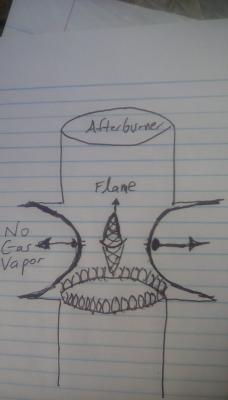This is it. There will be a collision at the center of a sphere of a magnetically charge phosphorescing dye. The tubes entering it, each tube will be composed of two tubes that join along the length, forming a cross section of the horn torus, like a dirt hornet's nest. They surround the surface of the sphere. The tubes that lead to that sphere will be wrapped to contain magnetic charge, as well as the inside surface of the sphere where the tube's boundary directed inward.
The hornet's nest (2 tubes joined from one flow of dye into the sphere) of that tube will be vortexed, so a vortex string of dye enters. When it collides the heat generated activates the phosphorescing lighting process. The youtube video, Shroedinger's Smoke, shows what happens when a trefoil knot is cavitated, or a pressure implosion, at 1:24, it shows a vaporous knot transforming into a torus. The same thing will happen here. The vortexed strings will knot, and form tori with vortexed and now lit vortexed strings of dye flowing through tori randomly in an array.
To accelerated the dye, the computer will be a large single torus, with opening into the tubes along the tube hole of the torus. Capped above and below the large torus will be a dome above and below. Two half hemispheres, connected to reciprocating pistons outside the 2 domes, connected to the hemispheres, will be driven down, creating a pressure peak inside the tubes of the main torus, that are linked to millions of small spheres (which connect to other spheres through the tubes that accelerate the dye). The reverse stroke induces cavitation by causing a rush of dye in the form of strings flowing through tori into the vacated space from the half hemispheres. The half hemispheres are flattened near their connection point.

That's an opposing force cylinder where the cylinders move left and right and produce that flame, but those two half hemispheres would be connected to that, so it's just compressing/decompressing the dye, and that cylinder (engine) would be above and below the dome of the computer driving the compression which accelerates the dye forming tori. The tori should be stable throughout the compression decompression, because after iniitial acceleration, it would just maintain the tori and keep the flow of lit strings of condensate flowing.
 Q&A (4871)
Q&A (4871) Reviews (203)
Reviews (203) Meta (439)
Meta (439) Q&A (4871)
Q&A (4871) Reviews (203)
Reviews (203) Meta (439)
Meta (439)